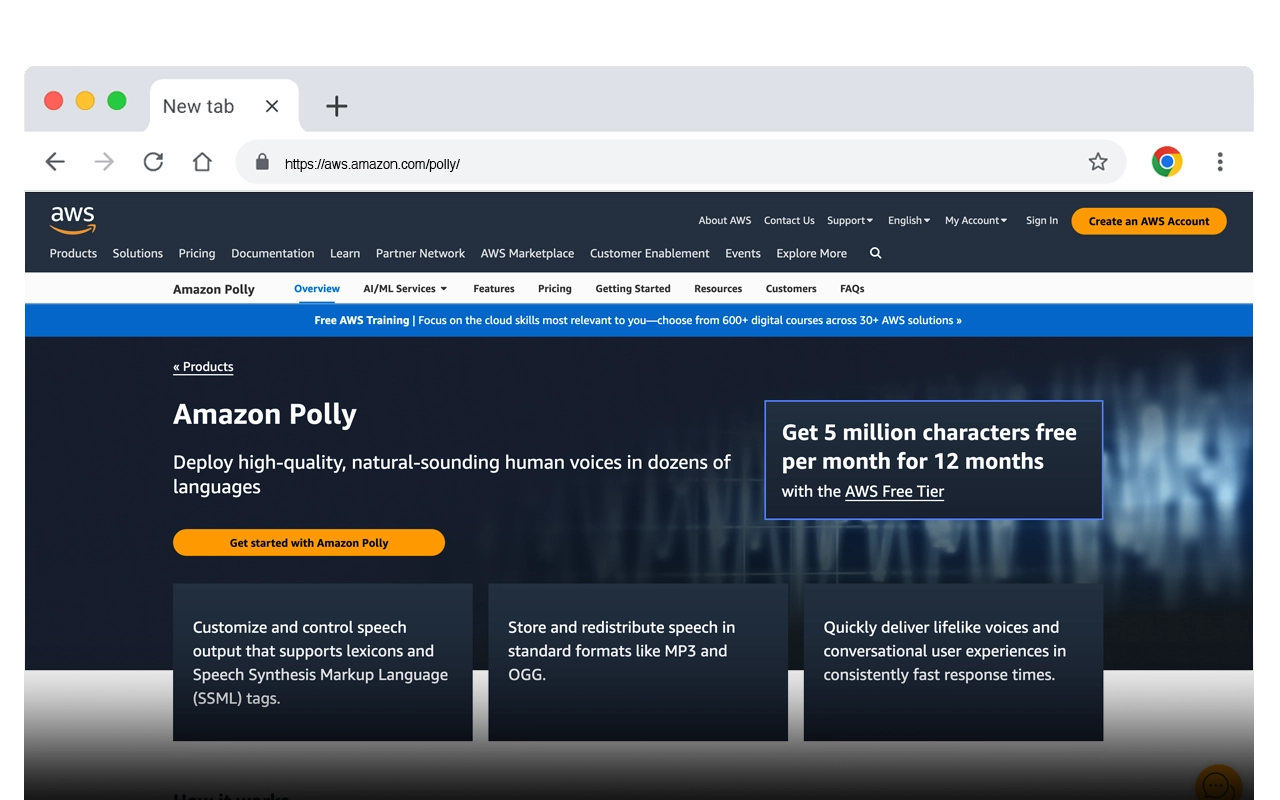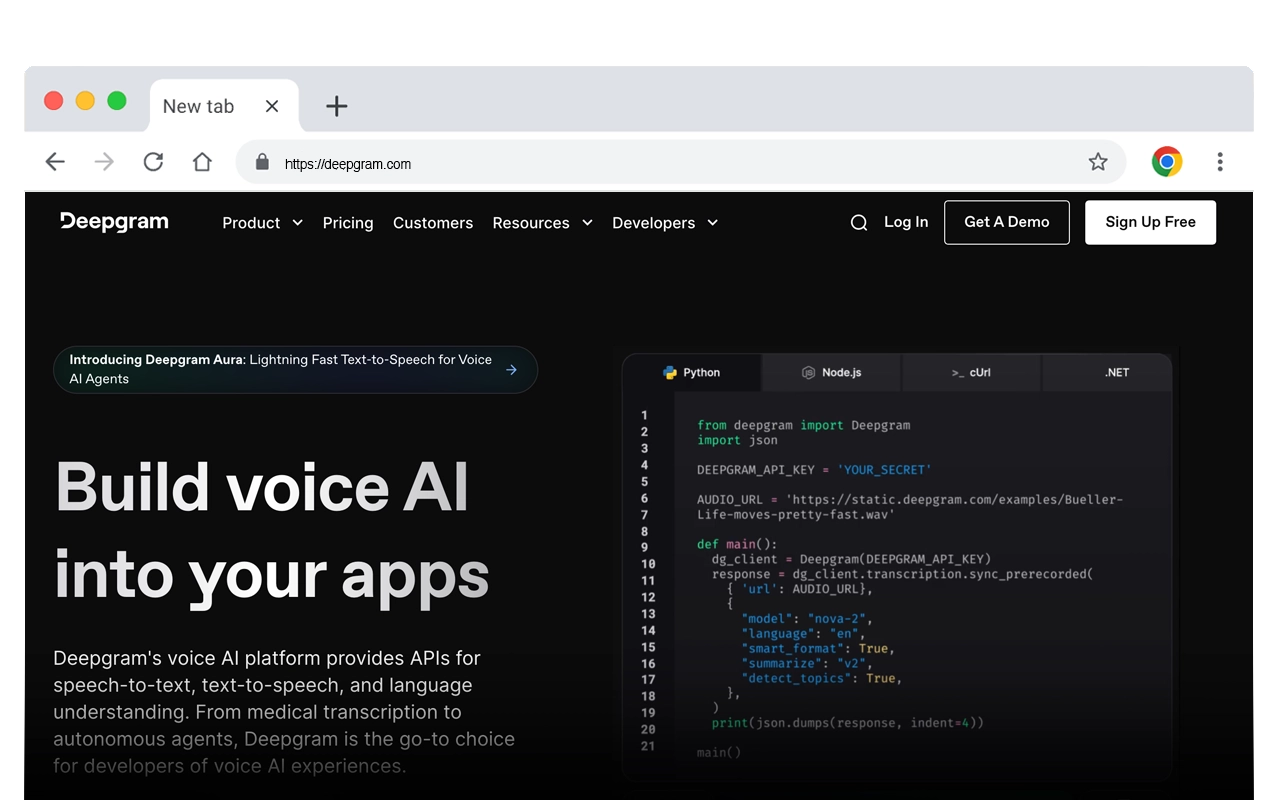Chatbots VS Conversational AI Learn the differences between Chatbots vs Conversational AI

Generate AI Voices, Indistinguishable from Humans
Get started for freeTable of Contents
Let’s dig into chatbots vs conversational AI. Chatbots yet have miles to go. Though there are some really good versions out there, they are yet in their infant stage. People are still wary of chatbots and they know they are talking to chatbots. The next evolution of chat bots is conversational AI, where you can speak with a bot and it can answer your questions. All while sounding very convincingly human.
To summarize chatbots vs conversational AI; Chatbots are text based and run off of conditions. conversational AI and AI agents, are self learning and you can verbally speak with them over a phone.
First, some stats
- According to Dashly, 84% of companies believe AI chatbots will gain importance for customer service and communication.
- By 2027, chatbots could become the primary means of interaction between companies and customers.
- Chatbots brought in 67% of sales.
There’s no denying it. Chatbots are here to stay. They are cheaper, they are on 24/7 and they are fast. No more “You are customer number 11 in the queue.” You are always the first in line.
In recent months the distinction between chatbots vs conversational AI has become a hot topic. As someone deeply immersed in this space, I’ve observed firsthand the confusion that often surrounds these terms.
Let’s break down the differences, the overlaps, and what sets these two technologies apart. By the end, you’ll not only understand the distinction but also how these rapid advancements are shaping the future of digital interaction.
Chatbots vs. Conversational AI
At a glance, chatbots and conversational AI might seem like different terms for the same technology. However, while they share common ground, they serve distinct purposes and possess unique capabilities.
Are chatbots AI?
To kick things off, let’s address a common question: Are chatbots AI? The answer is yes and no.
Clear as mud, isn’t it? But we’ll explain the differenced between chatbots vs conversational AI.
Traditional chatbots operate based on a set of predefined rules or scripts. They can handle basic queries and perform specific tasks based on those rules. So, in a way, they’re not “AI” in the sense of learning from interactions or understanding natural language on a deep level.
So, what is conversational AI?
Conversational AI, on the other hand, refers to technologies that utilize machine learning, natural language processing (NLP), and artificial intelligence to engage in human-like conversations. These systems learn over time, improving their responses and understanding context much more effectively than their rule-based counterparts.
Chatbots vs conversational AI: Key differences
- Learning Ability: The core difference lies in the ability to learn. Conversational AI gets smarter over time, adapting to users’ preferences and speech patterns. Traditional chatbots don’t learn; they follow a script.
- Natural Language Understanding: Conversational AI can grasp the nuances of human language, including slang and colloquialisms, making interactions more fluid and natural. Rule-based chatbots are limited to the commands they’ve been programmed with.
- Personalization: AI-powered conversational agents can personalize conversations based on past interactions, offering a more tailored experience. Chatbots typically can’t do this beyond basic script adjustments.
- Complexity of Tasks: Conversational AI can handle a wider range of tasks and inquiries, thanks to its understanding of context and ability to interpret intent. Chatbots are best suited for simpler, more straightforward tasks.
To understand chatbots vs conversational AI, perhaps a real-world demonstration would help. You can visit Play.ai and speak with any of the AI agents or call any of the numbers below.

Try a conversational AI agent:
- Call a doctors’ office: 1.310.919.0613
- Call a front desk: 1.650.600.0334
- Call your favorite restaurant: 1.312.313.6307
If you are ready to launch your own AI agent, contact Play.AI today!
Chatbots vs conversational AI: Complementary Forces
Despite their differences, it’s not a matter of conversational AI vs. chatbot; it’s about how they complement each other. For many businesses, a hybrid approach works best, combining the efficiency and scalability of rule-based chatbots with the sophisticated understanding and adaptability of conversational AI.
Chatbot use cases
To even better understand chatbots vs conversational AI, perhaps some use cases would help.
- Customer Service and Support: Chatbots are revolutionizing customer service by providing instant, 24/7 assistance to customers. They can handle a wide range of queries, from answering FAQs to troubleshooting common issues, thereby reducing wait times and freeing up human agents for more complex queries.
- E-commerce and Retail: In the e-commerce sector, chatbots offer personalized shopping experiences by recommending products based on user preferences and past purchases. They can also assist with order tracking, returns, and exchanges, making the shopping experience smoother and more engaging for customers.
- Booking and Reservations: Chatbots are being used by airlines, hotels, and restaurants for booking services. They can check availability, process reservations, and even handle special requests, simplifying the booking process for both businesses and consumers.
- Healthcare: In healthcare, chatbots offer a range of services from scheduling appointments to providing basic medical advice and reminders for medication. They can also assist in monitoring patient health and collecting patient data for further analysis.
- Education and Learning: Chatbots are making education more accessible and personalized. They can serve as virtual tutors, offering explanations, resources, and quizzes to help students learn at their own pace. Chatbots can also answer institutional queries for prospective students, such as course details, admission procedures, and campus information.
Conversational AI use cases
- Personalized Customer Service: Conversational AI can provide highly personalized customer support by accessing a customer’s history and preferences. This allows for more nuanced support and problem-solving, vastly improving the customer experience by offering solutions tailored to individual needs.
- Mental Health Support: AI-driven conversational agents are being used to offer preliminary mental health support, providing a safe space for individuals to express their feelings and thoughts. These agents can offer coping mechanisms, mindfulness exercises, and even help users identify when they might need to seek professional help.
- Financial Advisory Services: Conversational AI can act as a personal financial advisor, offering users insights into their spending habits, recommending savings strategies, and even providing investment advice based on the user’s financial goals and risk tolerance.
- Interactive Learning and Education: Beyond just serving as a knowledge base, conversational AI can create interactive and adaptive learning experiences. It can assess a student’s level of understanding, provide customized tutorials, and interact in a more engaging, conversational manner to facilitate deeper learning.
- Smart Home Management: Conversational AI integrates with smart home devices to manage home systems using natural language commands. Users can control lighting, temperature, security systems, and more through conversational interfaces, making smart home technology more intuitive and user-friendly.
The future is conversational AI
The future is really conversational. The old “if/then” approach of chatbots could be on the way out unless it sees rapid change. Conversational AI steps in where chatbots fail. Granted the branding of chatbots isn’t flattering. I for one don’t want to talk to a “chatbot”.
- 80% of customers will put up with a chatbot if they know they can speak with a human.
- 60% of customers still prefer waiting in a queue to speak with a human
It’s not the “chatbot” that is the deterrent, it’s the knowledge people have that they are speaking with a chatbot. As the borders get blurry between when a chatbot is speaking or a human, the apprehension fades away. Soon human voices and conversational AI agents will be indistinguishable.
Conversational AI is much more fluent and much more convincing. It also can be in audio or text form. The voices take on human qualities – with intonation, filler words, feedback, and a sense of “listening” and “understanding”. This helps customers feel like they are being taken care of.
Cold, if/then statements simply cannot get to this level of service.
Here’s a table comparing chatbots vs conversational AI
| Feature | Traditional Chatbots | Conversational AI Chatbots |
|---|---|---|
| Communication Modes | Text-only commands, inputs, and outputs | Voice and text commands, inputs, and outputs |
| Channels | Single channel: Typically just a chat interface | Omnichannel: Works across websites, voice assistants, smart speakers, and call centers |
| Conversational Flow | Pre-determined and scripted | Utilizes natural language processing for understanding and contextualizing |
| Interaction Style | Rule-based, canned, and linear. Struggles with tasks outside its script | Capable of wide-scope, dynamic, and non-linear interactions |
| Focus | Navigational, guiding users through a set path | Dialogue-focused, aiming for a natural conversation |
| Updates and Maintenance | Updating rules and flow requires reconfiguration, making it a manual and cumbersome process | Continual learning and fast iteration cycles make updates seamless |
| Scalability | Scaling is difficult and time-consuming due to manual updates and maintenance | Highly scalable, adapting as the company’s database and information evolve |
| Deployment | Building and setting up can be time-consuming and complex | Easy to deploy and integrate with existing systems and databases |
The Landscape of Conversational Technologies
Beyond the chatbot vs. conversational AI debate, the ecosystem includes various types of bots:
- Rule-Based Chatbots: Operate on “if this, then that” logic.
- AI-Powered Chatbots: Use machine learning and NLP for more nuanced conversations.
- Voicebots vs. Chatbots: Voicebots are like chatbots but designed for voice interactions, expanding accessibility and use cases.
- Conversational AI Bots: Encompass both chat and voice bots, utilizing AI for natural interactions.
As we navigate the nuances of chatbots vs. conversational AI, it’s clear that both have their place in the digital ecosystem. Whether it’s a simple chatbot guiding a user through a website or a sophisticated conversational AI providing personalized customer support, these technologies are shaping the future of how we interact with the digital world. The key is understanding their strengths and limitations, and how to leverage them to enhance user experiences.
The distinction between chatbot and conversational AI is just the beginning. As we push the boundaries of what these technologies can do, the future of digital communication looks incredibly promising.
What is NLP?
NLP (Natural Language Processing) enables conversational AI to understand, interpret, and generate human language, making interactions between humans and machines more natural.
Examples of conversational AI in business?
Businesses use conversational AI for personalized customer support, sales assistance, and feedback collection, enhancing the customer experience significantly.
Limitations of conversational AI?
Conversational AI chatbots sometimes struggle with understanding complex queries, slang, and can exhibit bias if not properly trained.
How does conversational AI learn?
Conversational AI learns through machine learning algorithms, analyzing interactions to improve responses and adapt to new language trends.
Privacy concerns with conversational AI?
In industries like healthcare and finance, using conversational AI raises concerns about data security and privacy, requiring strict compliance with regulations.
Integrating conversational AI with databases?
Companies integrate conversational AI with existing systems through APIs, allowing the AI to access and utilize data for more informed interactions.
Cost of conversational AI vs. traditional chatbots?
Implementing conversational AI typically costs more initially than traditional chatbots due to its advanced capabilities, but can offer better ROI through enhanced user experiences.
What’s the user response to conversational AI?
Users generally respond positively to conversational AI due to its more natural and personalized interactions, improving overall user experience. The voices sound convincingly human and the responses are under 300 miliseconds.
Future of conversational AI?
We can expect advancements in understanding capabilities, personalization, and integration across platforms, making conversational AI more versatile and effective.
Ethical concerns with conversational AI?
Deploying conversational AI raises ethical considerations, including the potential for bias and misinformation, necessitating ongoing monitoring and adjustments.
Text To Speech Leaderboard
| Company Name | Votes | Win Percentage |
|---|---|---|
| PlayHT | 537 (676) | 79.44% |
| ElevenLabs | 98 (191) | 51.31% |
| Speechgen | 24 (177) | 13.56% |
| TTSMaker | 65 (174) | 37.36% |
| Listnr AI | 58 (168) | 34.52% |
| Uberduck | 86 (166) | 51.81% |
| Resemble AI | 74 (156) | 47.44% |
| Narakeet | 65 (154) | 42.21% |
| Speechify | 68 (153) | 44.44% |
| Typecast | 43 (140) | 30.71% |
| NaturalReader | 15 (49) | 30.61% |
| Murf AI | 10 (42) | 23.81% |
| WellSaid Labs | 10 (40) | 25.00% |
| Wavel AI | 9 (38) | 23.68% |
Similar articles

Best Text to Speech Software in 2025

Conversational AI for Customer Service

Murf AI Pricing: Comprehensive Analysis

Cartesia AI Pricing: A Detailed Overview

Resemble AI Pricing: A Detailed Look

Amazon Polly Text to Speech Pricing: A Comprehensive Guide

Azure Text-to-Speech Pricing: A Detailed Overview

ElevenLabs Pricing: A Complete Guide

Deepgram TTS Pricing: A Comprehensive Guide

Speechify Pricing: Plans, Features, and Costs Explained

WellSaid Labs Pricing: A Complete Overview

Automated Voice Message: Enhancing Communication for Modern Businesses

Free Voice Changer: The Best AI Voice Changers Online

AI Appointment Booking: A Game-Changer for Your Business

PDF Text to Speech: Unlocking the Power of Audiobooks from PDFs

































































































